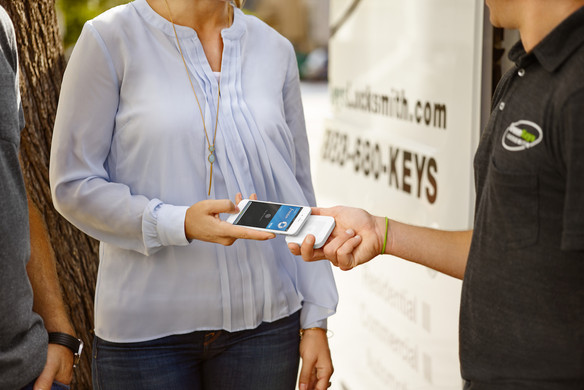Table of contents
If you’ve stood in line at Whole Foods or Walgreens lately, you may have noticed customers holding up their mobile devices to check out. It’s likely they’re paying with Apple Pay, Android Pay, or Samsung Pay.
These types of transactions are examples of NFC (aka “near field communication”) payments, and have many benefits for both consumers and merchants. Here’s everything you need to know about NFC—and why it makes sense to start accepting this new form of payment at your business.
They’re super-fast.
The EMV chip card migration is marching forward. In December 2015, roughly 53 percent of cards processed on Square Stand were EMV chip cards, up from 12 percent last January. The nationwide switch to EMV is a good thing for security and fraud reduction (EMV is much more secure than magstripe). But if you’ve paid with a chip card, you’ve probably noticed how slow it is. Chip cards take noticeably longer to process than magstripe cards — several seconds longer, in fact. NFC mobile payments are faster than both. All customers have to do is hold their mobile device close to an NFC-enabled reader with their finger on the identification button, and the transaction completes immediately. And when you have a long queue, a faster transaction time means a faster line (and more sales).
It’s extremely secure.
Since paying through your mobile device is a relatively new technology, its security may be something you have questions about. But NFC transactions are extremely secure. Arguably, they’re the most secure way to pay and to process payments. NFC transactions are authenticated payments, meaning there are several sophisticated layers of security built into the transaction. The technology works through a process called tokenization, which scrambles bank details into a “token,” a number that’s a stand-in for the credit card number. A different token is used for each transaction. All these security layers make it almost impossible for a fraudster to hack the data and do anything shady. Apple Pay is also protected by Apple’s fingerprint technology, Touch ID. So even if you lose your phone, no one can get at your data.
It’s poised to take off.
NFC mobile payments are poised to take off in the United States. A recent report from analyst firm TrendForce predicts that consumers worldwide will use their mobile phones to spend a total of $620 billion U.S. dollars on all forms of mobile transactions this year, a 37.8 percent increase over 2015. And the same report predicts that by 2017, total mobile payment volumes will reach $780 billion. Countries that have already switched to EMV as the card-processing standard are leading this charge. This is likely because chip cards are so slow to process, and NFC payments offer a much faster, more convenient experience (while still being secure). As the EMV migration reaches saturation in the United States, it’s likely we’ll see the same adoption of contactless payments like Apple Pay.
In short, NFC payments are fast, secure, and convenient. To stay ahead of the curve, and to make sure you can safely accept any form of payment that comes across your counter, it’s worthwhile to start accepting NFC mobile payments now.
![]()











